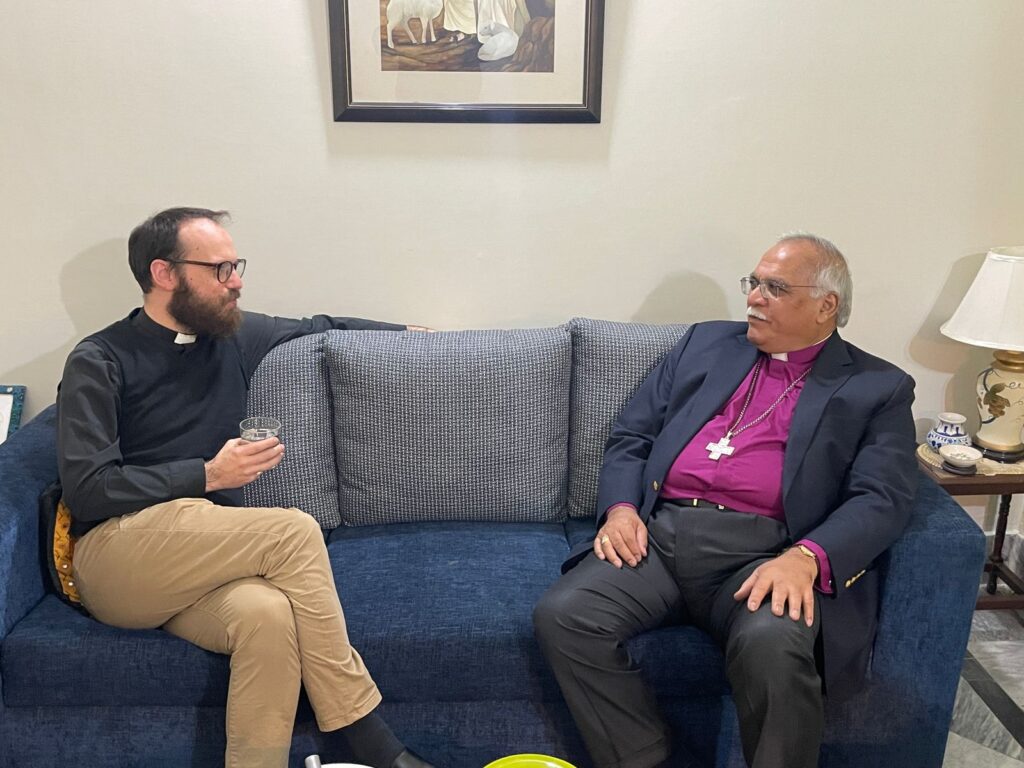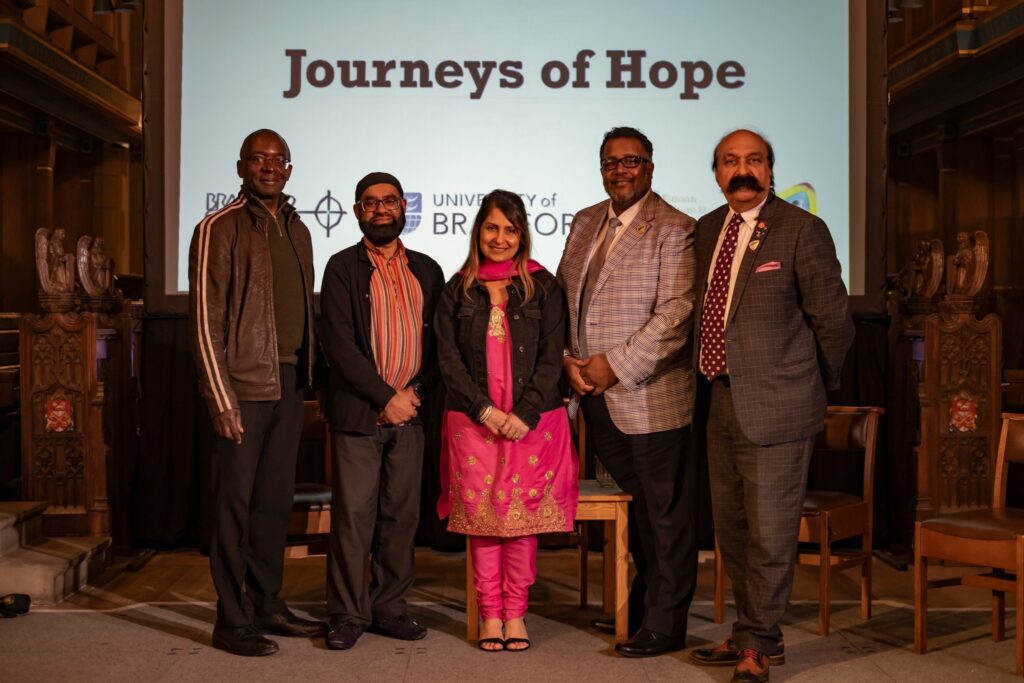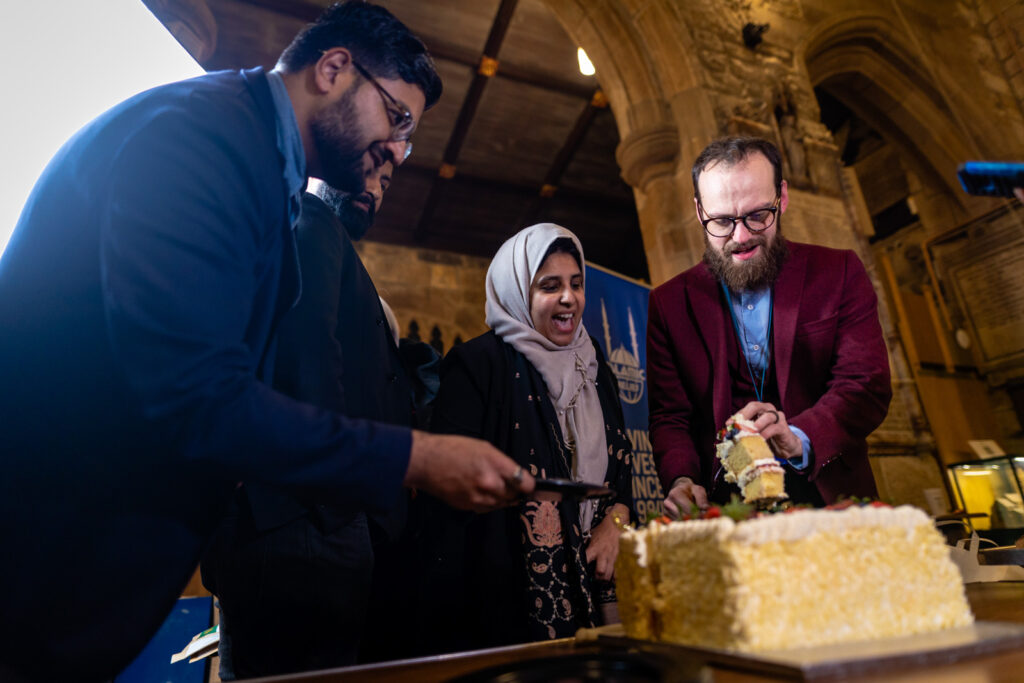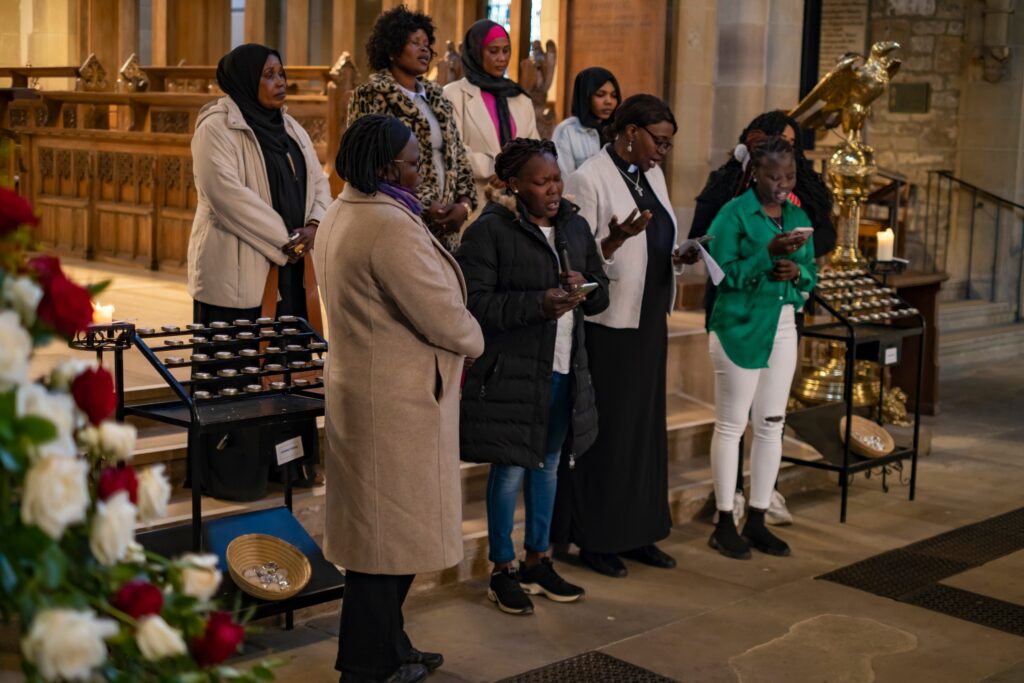
A prepared introduction is read out, in Urdu, in the Central Cathedral Church of the Praying Hands.
“Rev. Canon Ned Lunn is a pastor at Bradford Cathedral. He works cross culturally using the arts to tell people about Jesus.”
The minister who reads this has been to Bradford and tells the congregation of his fond memories of his time there. He talks about how he felt at home there because there were so many Pakistanis in the city. I hear my name and my host ushers me to go to the microphone. As I walk up I regret not preparing what to say and try to pray.
How do I greet them in Urdu? After all my learning on greetings I still am uncertain as to how to begin conversations. Urdu has a complicated etiquette about greeting as it depends on the faith of the person one is greeting. As Pakistan is a Muslim country the usual way of greeting is “As-salamu alaikum” but that will not do in Church.
“Khuda shukriya (Thank you, God)”
It will do.
“Thank you for your welcome. I do feel at home here as there are similarities between Bradford and Pakistan… mainly the driving!”
This is met by laughter. Having experienced only two journeys on Pakistani roads I understand some of my fellow Bradfordians’ frustratingly ‘different’ style of driving. I don’t agree with it but I understand it.
“I send greetings from Bradford Cathedral where we pray for you each week and particularly over the last few months after the attacks in Jaranwala. I have sat and wept with Pakistani Christians in Bradford and we pray God’s protection and redemption over the whole Church of Pakistan.”
I still fear that my writing is dangerous and a pang of paranoia hits me in the throat. Bishop Azad Marshall sits on the other side of the Cathedral but I cannot see him as he is slightly behind me over my right shoulder. I swallow hard and find no words coming to mind.
“Say something profound.” My inner voice screams, but I have nothing. “Well, say something funny then.” Do I mention the cricket? “Say anything!”
“I do not speak Urdu. I am sorry. Shukriya (thank you) for your welcome…”
I stutter to a stop and the familiar wave of self loathing washes over me. I am out of my depth.
It’s after the service and a group of clergy are sat around a small room listening to Bishop Azad trying his best to find a topic of conversation with me. He asks about my trip.
“I am here for three reasons: 1. To learn what it means to be a public Christian community in a majority Muslim population. 2. To learn how Muslim’s engage in the arts and what are the potential fruitful artistic spaces in which we can have meaningful dialogue and 3. To build personal friendships with the Church of Pakistan to deepen the meaning in our diocesan link.”
Bishop Azad considers for a moment and repeats my host’s reflections.
“You are more generous with Pakistani Muslims than they are to us.”
He talks passionately about the history of Christianity in, what is now known as, Pakistan. He reminds me of the apostolic line from St Thomas (never called ‘doubting’ in the Indian sub-continent), the Jesuit, Jerome and his conversations with Akhbar the Great, the Mughal Emperor and of the Christian schools and hospitals that sustained the newly formed state of Pakistan after the Partition.
“We are a public presence in this country but our road to political representation is fraught with difficulty.”
I repeat some of my reflections of the last few days and remember that I am here to learn and listen.
“How was your trip?” (Bishop Azad has recently returned from England)
He sighs. It looks like he is considering whether to be unguarded but decides, instead, to smile.
“It was ok.”
No further questions, then.
“What can we do for you?” he asks.
The Church of Pakistan is a conservative province in the Anglican Communion when it comes to issues of sexuality and gender. This fact weighs heavy in the room. I consider my response.
“Tell your story and continue to witness to the unique story of Jesus, for we have lost sight of the powerful, radical, countercultural narrative of the cross in the West.”
In an attempt to remain hopeful I share the testimony of Paul Kingsnorth and of Justin Brierley’s new book, ‘The Surprising Rebirth of Belief in God’ which shows signs that faith is returning to Europe. But I find myself returning to the deepening dissatisfaction and ‘disenchantment’ that our culture is creating and the desperation of my people. I talk about the seeming hopelessness seen in the unshifting increase in suicide and addictive behaviours despite all the many ‘causes’ and proposed solutions to the crises we face.
“Lord, have mercy upon us.”
I pause. I look around at these ministers who publicly declare their faith and who, if they suggested anything like what is being promoted in the Church of England around morality, would face ridicule and violent persecution.
“We need your prayers and witness more than you need ours.”
Do I really mean that? Yes, I think I do.

“It is sad to see,” Bishop Azad responds, “the Church that sent us so many missionaries and grew the Church here in such a state.”
“You could send some back!” I quip.
The apostolic tradition is a significant and undervalued aspect of the Church of England’s discussion on the moral/ethical issues we face. Apostleship is understood too much as the pioneering, church-planting idea of this work. For me apostleship is more about leadership of the mission and ministry of the Church. If Evangelism is the ‘telling’ and Discipleship is the ‘teaching’ the Apostleship is the ‘treasuring’. It is this ministry that doesn’t just point forward to the new but also points back to the trusted inheritance. This is what I think I want from the Church of Pakistan, and indeed, the Coptic Church too. I want an apostolic ministry to remind me of the Early Church Fathers and Mothers, the martyrs and prophets. I want missionaries to come and show me a faith that means something, that is truly countercultural and distinct from what the world is offering.
There is such a need for a grasping, not just of the novel and new but of the ancient and discarded. To believe in the communion of saints isn’t, for me, so much a ghostly orchestra of holy people of the past but a sharing in the life and truth that they lived in their time. This is what it means for me to stand in an apostolic succession. To believe that there is an unchanging, universal way of life; one undeniable truth to the question, ‘what does it mean to be human?’: a singular life that conquers death. This is the apostolic. To lead ourselves and others to the treasure buried in a field.
As I leave, one of the Cathedral clergy stops me.
“I am grateful to God that the Church of England has some of your thought and consideration.”
I am humbled… and then internally dismiss the compliment because it makes me feel uncomfortable.














